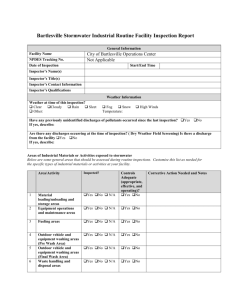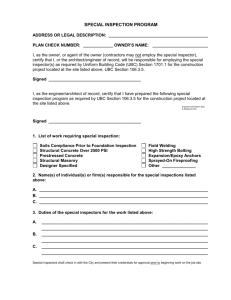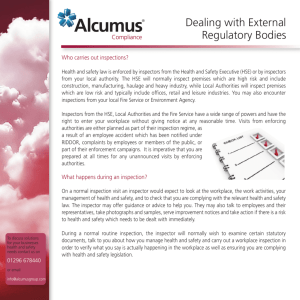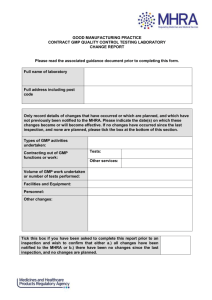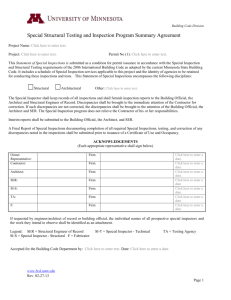UCCS S O P
advertisement
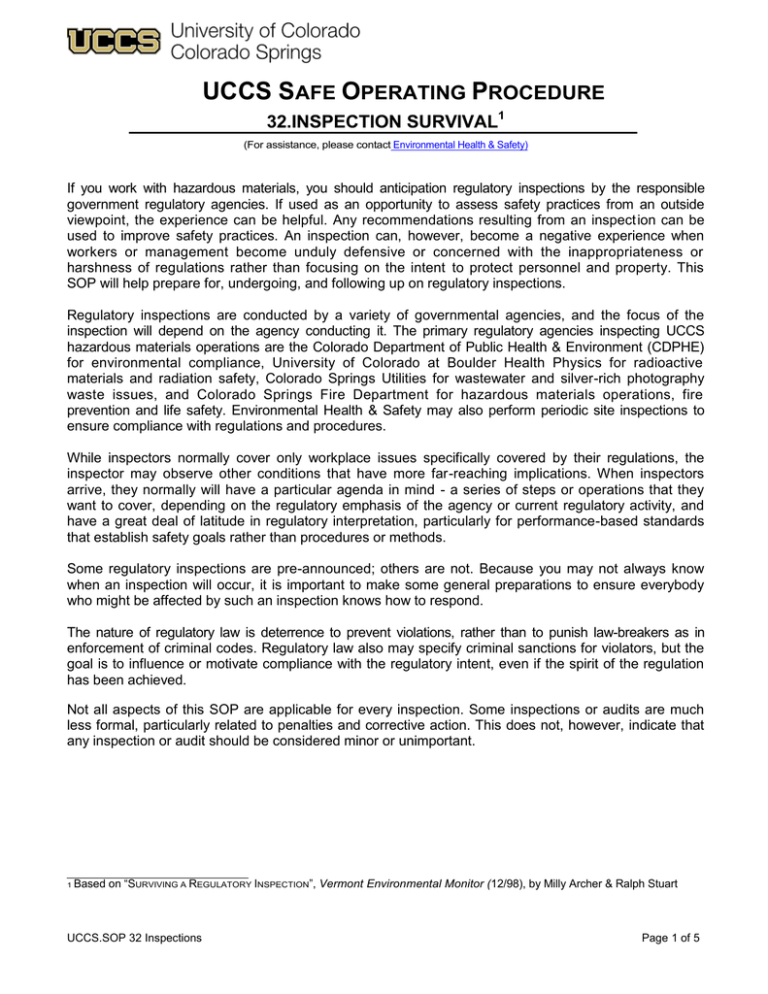
UCCS SAFE OPERATING PROCEDURE 32.INSPECTION SURVIVAL1 (For assistance, please contact Environmental Health & Safety) If you work with hazardous materials, you should anticipation regulatory inspections by the responsible government regulatory agencies. If used as an opportunity to assess safety practices from an outside viewpoint, the experience can be helpful. Any recommendations resulting from an inspect ion can be used to improve safety practices. An inspection can, however, become a negative experience when workers or management become unduly defensive or concerned with the inappropriateness or harshness of regulations rather than focusing on the intent to protect personnel and property. This SOP will help prepare for, undergoing, and following up on regulatory inspections. Regulatory inspections are conducted by a variety of governmental agencies, and the focus of the inspection will depend on the agency conducting it. The primary regulatory agencies inspecting UCCS hazardous materials operations are the Colorado Department of Public Health & Environment (CDPHE) for environmental compliance, University of Colorado at Boulder Health Physics for radioactive materials and radiation safety, Colorado Springs Utilities for wastewater and silver-rich photography waste issues, and Colorado Springs Fire Department for hazardous materials operations, fire prevention and life safety. Environmental Health & Safety may also perform periodic site inspections to ensure compliance with regulations and procedures. While inspectors normally cover only workplace issues specifically covered by their regulations, the inspector may observe other conditions that have more far-reaching implications. When inspectors arrive, they normally will have a particular agenda in mind - a series of steps or operations that they want to cover, depending on the regulatory emphasis of the agency or current regulatory activity, and have a great deal of latitude in regulatory interpretation, particularly for performance-based standards that establish safety goals rather than procedures or methods. Some regulatory inspections are pre-announced; others are not. Because you may not always know when an inspection will occur, it is important to make some general preparations to ensure everybody who might be affected by such an inspection knows how to respond. The nature of regulatory law is deterrence to prevent violations, rather than to punish law-breakers as in enforcement of criminal codes. Regulatory law also may specify criminal sanctions for violators, but the goal is to influence or motivate compliance with the regulatory intent, even if the spirit of the regulation has been achieved. Not all aspects of this SOP are applicable for every inspection. Some inspections or audits are much less formal, particularly related to penalties and corrective action. This does not, however, indicate that any inspection or audit should be considered minor or unimportant. 1 Based on “SURVIVING A REGULATORY INSPECTION”, Vermont Environmental Monitor (12/98), by Milly Archer & Ralph Stuart UCCS.SOP 32 Inspections Page 1 of 5 Preparing for an Inspection 1) Be prepared for an inspection at all times. This means that in your daily routines, you have to develop practices that can be explained to a regulator in terms of the regulations. For example, how do your chemical storage practices compare to fire code, environmental or safety regulations? Regulations are not intended to provide practical “how to” guidance, but broad principles and requirements. 2) Create paperwork with "due diligence". A thorough “paper trail” is essential to assure regulators that you are aware of, and complying with regulations. Documentation of how your program relates to the regulation is physical evidence of good faith intentions to meet the regulation. “How much paperwork is enough? The answer depends on "due diligence" - have you done what a reasonable person would to assure your operation is in compliance? In case of a dispute of facts or regulatory interpretation, a pre-existing piece of paper will carry significantly more weight than oral testimony. Computer databases and other electronic means are becoming more common, but they must be carefully documented to provide evidence of compliance. 3) Be aware of what regulations apply to your work site. Due to the wide range of regulations that apply to hazardous materials operations, even from a single agency, you must prioritize which regulatory concerns you document to what level. It is unlikely that you can document everything and maintain documentation continually current, while still getting some work done. 4) Determine which regulations are of primary concern for your operation, determine your compliance status for these regulations and develop the documentation to prove it. Periodic review of applicable regulations and audit of your documentation may reveal gaps between your program and a particular regulation. Revise current paperwork to bridge those gaps, or develop a new paper trail as required to demonstrate compliance. The more recently your review, the more likely you are to be able to "speak the language" of the inspector. 5) Designate a single spokesperson to deal with the agency throughout the inspection process (be sure that an alternate is available - inspectors are unlikely to wait for a more convenient moment). This should be the highest-level person that understands both the worksite procedures and the applicable regulations. It is important that inspectors sense that the organization is aware of and prepared. Giving inspectors the run around or conflicting answers quickly erodes any preparation. UCCS.SOP 32 Inspections Page 2 of 5 Inspection Process 1) The Opening Conference a) Upon arrival, the inspector should start out with an opening conference, which may be formal or informal. Inspector(s) and participating University representative(s) will introduce themselves and get organized. No environmental or fire-related regulatory inspection should take place without the participation of EH&S. A representative of the University should accompany the inspectors at all times while on campus. b) The reason for the inspection should be made clear at this time. If the inspector is investigating a complaint, the company representative should find out how much background information the inspector has, and be sure that it is accurate. In these cases, it is important to focus on issues directly relating to the complaint, although other concerns may arise in the course of the inspection. For a routine inspection, it is prudent to establish the framework for issues to be covered and a tentative time schedule so all participants know what to expect. 2) The Inspection. A complaint investigation normally focuses specifically on the factors and particulars related to the complaint, but cold also be the impetus for a more extensive inspection. An inspection checklist may be available from the regulating agency to help give a sense of the extent of the typical inspection. Inspections have two main elements: a document and a workplace walk-through. a) Document review. This may or may not be required. All paperwork maintained by the organization to demonstrate compliance, such as training records, shipping documents, and emergency plans, should be readily available. It is convenient, though not required, that the inspector be provided a designated workplace during the course of the inspection. i) Neither the inspectors nor the organization benefit when the inspector has to weed through extraneous paperwork to locate pertinent information, so all documentation should be presented in an organized manner. ii) Focus on helping the inspector understand the relevant aspects of your compliance program. Don't second-guess what the inspector wants to see or know - this is only likely to create suspicions. iii) It is important to be sure that the inspector addresses only applicable requirements and to clarify any circumstances which exempt you from particular regulations. Refer to EH&S if there are any questions iv) Make copies of all documents given to the inspector during the inspection to develop an inspection-specific file. b) Workplace walkthrough. This may or may not be required. i) The purpose of the walk through is to determine how accurately the paperwork portrays actual physical conditions. ii) During the walk-through, the inspector may talk to employees, take pictures of existing conditions, and check for any paperwork that should be available to employees (for example, labels or material safety data sheets) or at the actual worksite. iii) Duplicate pictures of any the inspector takes should be taken so that you can review the inspection with solid information about what they saw. iv) Employee interviews may be held in private, or in the presence of the company's representatives, depending on the nature of the inspection. 3) The Closing Conference a) Regulatory inspections should end with a closing conference at which time the inspector should identify any problems observed. If it appears the inspector is preparing to leave campus without UCCS.SOP 32 Inspections Page 3 of 5 a closing conference, ask for one. Information obtained at the closing conference will provide the facts necessary to prepare a follow-up written response and begin correcting any problems identified during the inspection. b) Get a copy of the completed inspection sheet or log before the inspector leaves. Remember this may be a preliminary report and not conclusive – the inspector may need to consult with their supervisors about specific issues that have arisen during the course of the inspection. c) Any violations should clearly cite the regulation or law that governs the specific activity, location or procedure. Without this citation any inspector opinions, comments or recommendations should be clearly documented to indicate they are not violations. 4) Follow-up Actions a) Inspection Report. After an inspection, the University will receive a letter or other official form from the agency reporting inspection findings and conclusions, including any citations of violations. University follow-up does not have to wait for this formal report. Early correction of as many problems as possible and documenting this to the agency can often affect the impact and tenor of any violations. b) Immediate Follow-up. If possible, an alleged violation should be rectified before the inspector leaves the worksite. i) For example, if an inspector determines that there is insufficient signage in your hazardous waste storage area, you may be able to produce and post appropriate signs before the inspector leaves, and the inspector may document that the problem was corrected during the inspection. ii) Immediate follow-up may take the form of a written response to clarify an issue or state your interpretation of a regulation and how it applies to your worksite. This follow-up letter should be sent to the regulating agency as soon after the inspection as possible. iii) The follow-up letter should address every problem documented by the inspector on the inspection checklist or in the closing conference log. iv) The alleged violations should be addressed by describing the corrective actions taken, (e.g. "We over packed the leaking five-gallon container into an approved 30-gallon container before the inspector left the site,") or by setting a self-imposed compliance schedule (e.g. "HAZWOPER training for the new employee has been scheduled for May 15.”) 5) Inspection Results a) For minor problems or violations, the regulatory agency may issue a warning letter, schedule a follow-up inspection, or initiate enforcement action. i) For minor violations where voluntary compliance is anticipated, regulatory agencies commonly issue a warning letter or a notice of alleged violation outlining the problems documented during the inspection. ii) Response to this type of notification requires written certification that the problems have been corrected. Fines are not typically associated with these warning letters. iii) A reinspection is common for this type of violations. b) Regulating agencies may choose to initiate enforcement action as a result of violations observed. The extent of enforcement action and penalty assessed takes into account many factors: i) Did the violation threaten to, or actually cause, physical harm? How substantial was the actual or potential harm? ii) W ere there mitigating circumstances? iii) W as the violation committed knowingly? iv) Did the violator gain an economic benefit as a result of the violation? v) How long has the violat ion existed? UCCS.SOP 32 Inspections Page 4 of 5 vi) Was the violation associated with a rule, a law or a permit condition? vii) What is the violator's previous record of compliance? viii) What were the regulatory agency's expenses associated with the enforcement effort? ix) What is the deterrent effect of the penalty? c) In more serious cases, a penalty may be assessed after the inspection is reviewed and the violation has been evaluated by the regulating agency. i) The penalty assessment is usually broken down by violation and presented in the form of a draft settlement document, including monetary penalties when appropriate. ii) This document is the starting point for negotiations with t he agency. 6) Negotiating penalties a) The University may choose to avoid the costs of negotiating and litigating a penalty assessment by returning the settlement document to the regulating agency, thereby agreeing to the penalties. b) The regulating agency may agree to reduce the proposed penalty amount by some percentage in return for a settlement and payment of the penalty without negotiations or litigation. c) If the University believes any citations are inaccurate or penalties ar e excessive, they may choose to negotiate the terms of the citations. i) Legal counsel may be necessary at this stage. ii) When enforcement actions raise issues regarding process operations or other environmental health and safety or engineering issues, it may also be prudent to hire a technical consultant. iii) Obtain a copy of the applicable penalty policy to determine the criteria by which the penalty was assessed. iv) The regulating agency normally desires expeditious resolution of citations so may be open to negotiation, alternative dispute resolution or mediation to minimize delays. v) Resolution of the issue is not likely to happen quickly; it is not unlikely that several months may pass before an agreement is reached. d) It may be possible to reduce the penalty if the University agrees to a project that remediates the adverse public health or environmental consequences of the violations beyond the normal requirements of the law. These are referred to as supplemental environmental projects or SEPs, and they may be categorized by policy what must be done in order to reduce specific penalties. e) Environmental health and safety enforcement settlements have a clear goal to accomplish full compliance with applicable laws and regulations, accompanied by a financial penalty that recovers the economic benefit of noncompliance. Last reviewed by Cynthia Norton December 15, 2015 UCCS.SOP 32 Inspections Page 5 of 5
